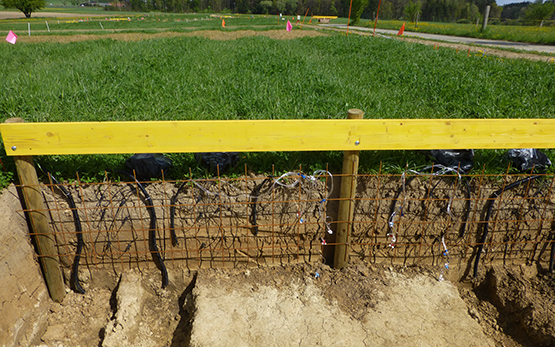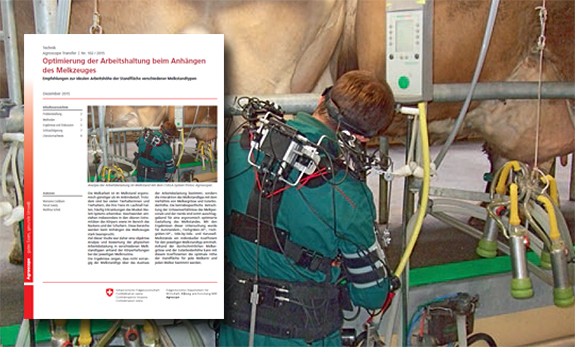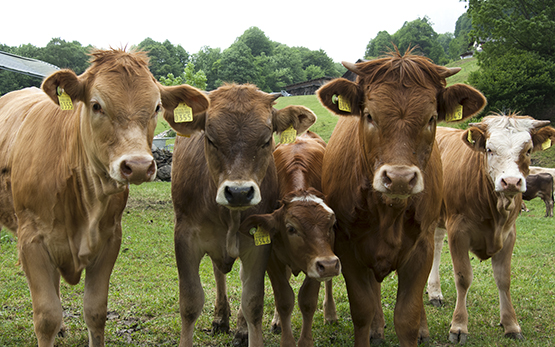Zeitler-Feicht M. H., Hartmann E., Erhard M. H., Baumgartner M.
Which affiliative behaviour can be used as a valid, reliable and feasible indicator of positive welfare in horse husbandry?
Applied Animal Behaviour Science, 273, 2024, 1-11.
Baumgartner M., Krüger L., Kuhnke S., Erhard M. H., Zeitler-Feicht M. H.
Bewertung der Tiergerechtheit und Umweltwirkungen von Pferdehaltungen.
Der Praktische Tierarzt, 105, (4), 2024, 364-377.
Helmerich P., Bachmann I., Gygax L.
Comparing lying behaviour of young riding horses on days in an individual indoor box, on an outdoor paddock alone, or in pairs and in the following night.
Equine Veterinary Journal, In Press, 2024, 1-5.
Lüthin S., Zollinger A., Basso W., Bisig M., Caspari N., Eng V., Frey C. F., Grimm F., Igel P., Lüthi S., Regli W., Roelfstra L., Rosskopf M., Steiner B., Stoeckli M. et autres
Strongyle faecal egg counts in Swiss horses: A retrospective analysis after the introduction of a selective treatment strategy.
Veterinary Parasitology, 323, 2023, 1-8.
Roig-Pons M., Tomozyk S., Gardes L., Briefer S.
Roughage and type of dispenser: What consequences on horse's feeding behaviour?
Dans: EAAP. 5 September, Lyon. 2023, 1-25.
Roig-Pons M., Prats C.
Time-controlled hayracks for horses, what effect on behaviour ?: An exploratory study.
Dans: EAAP. 5 September, Lyon. 2023, 1-26.
Roig-Pons M.
Feeding horses in groups: Hay availability and horses' welfare.
Dans: Joint Graduate Meeting - DZG. 9 November, Bielefeld. 2023, 1-29.
Heikkilä U., Ueda K., Gobbo Oliveira Erünlü N., Baumgartner M., Cockburn M., Bachmann I., Roig-Pons M., Rieder S.
Social network analysis of horses inferred from sensor ear tag and GPS-logger data.
Dans: EAAP 74 Annual Meeting. 26 Augus, Lyon. 2023, 652.
Heikkila U., Ueda K., Baumgartner M., Cockburn M., Bachmann I., Roig-Pons M., Rieder S.
Social network analysis of horses inferred from sensor ear tag and GPS-logger data.
Dans: EAAP 74 Annual Meeting. 26 August, Lyon. 2023, 1.
Baumgartner M., Krüger L., Zeitler-Feicht M.H., Bachmann I.
How horse-friendly are our stables?: Requirements vs. practice.
Dans: Research days - Horse Health and Grassland. 21 Sep, Ed. Sandgrueb Foundation, 2023, 40-41.
Baumgartner M., Krüger L., Zeitler-Feicht M.H., Bachmann I.
How horse-friendly are our stables?: Requirements vs. practice.
Dans: Research Days - Horse Health and Grassland - Annual Meeting of the Sandgrueb Foundation research partners. 21 September, Szepalma. 2023, 1.
Baumgartner M., Krüger L., Erhard M. H., Zeitler-Feicht M.H.
Forschung zum Tierschutz bei Pferden: Research on animal welfare in horses.
Dans: Michael Erhard Symposium: Tierschutz altert nicht - Wissenschaft für mehr Tierschutz. 28. Juli, Ed. Kuratorium für Technik und Bauwesen in der Landwirtschaft e. V. (KTBL), Darmstadt. 2023, 67-76.
Ellerbrock C. N., Zeitler-Feicht M., Cockburn M., Erhard M.H., Baumgartner M.
Urinating in transponder-controlled feeding stations: Analysis of an undesirable behaviour in horses.
Applied Animal Behaviour Science, 266, 2023, 1-10.
Briefer S., Bachmann I.
Comment les chevaux expriment-ils leur stress : l'effet des « coping styles » sur les indicateurs comportementaux ?
Dans: 17e journée de recherche équine. 20 avril, Avenches. 2023, 18-19.
Gardes L, Roig-Pons M.
Type de fourrage et dispositifs d'affouragement : Quelles conséquences sur le comportement alimentaire et la posture des chevaux?
Dans: 17e Journée de recherche équine suisse. 20 avril, Ed. Agroscope, Haras national suisse HNS. 2023, 13-14.
Roig-Pons M., Briefer S.
Filets à foin : Quels risques pour la santé de nos chevaux?
Dans: 17e Journée de recherche équine suisse. 20 avril, Ed. Agroscope, Haras national suisse HNS. 2023, 28-29.
Roig-Pons M.
Is the use of haynets for horses associated with increased health risks?: A cohort study.
Dans: Walks & Talks. 14 June, Neuchâtel. 2023, 1-41.
Roig-Pons M.
Chevaux et slowfeeders : évaluation des conséquences sur la santé et le comportement.
Dans: Journée des doctorants de la filière équine. 31 mai, Saumur. 2023, 1-2.
Roig-Pons M., Briefer S.
L'utilisation de filets à foin est-elle associée à des risques pour la santé de nos chevaux?
Dans: Journée de recherche équine suisse. 20 avril, Avenches. 2023, 1-40.
Gardes L., Roig-Pons M.
Type de fourrage et dispositifs d’affouragement : quelles conséquences sur le comportement alimentaire et la posture des chevaux?
Dans: Journée de recherche équine suisse. 20 avril, Avenches. 2023, 1.
Roig-Pons M., Briefer S.
Is the use of haynets for horses associated with increased health risks?
Dans: GCB Symposium. 29. June, Ed. University of Bern, Bern. 2023.
Baumgartner M., Hartmann E., Erhard M. H., Zeitler-Feicht M. H.
Welche affiliativen Verhaltensweisen eignen sich als valider, reliabler und praktikabler Indikator für Wohlbefinden in der Pferdehaltung?
Agroscope Science, 133, 2023, 24.
Baumgartner M., Erhard M. H., Zeitler-Feicht M. H.
Welches Tier-Fressplatzverhältnis an zeitgesteuerten Heuraufen ist tiergerecht?: Explorative Feldstudie zu Stressreaktionen von Pferden.
Agroscope Science, 133, 2023, 34-35.
Ellerbrock C., Zeitler-Feicht M. H., Cockburn M., Erhard M. H., Baumgartner M.
Analyse des unerwünschten Verhaltens “Urinabsatz in Abrufautomaten“ von Pferden.
Agroscope Science, 133, 2023, 36-37.
Kuhnke S., Baumgartner M.
Heuraufen müssen sicher sein.
Rheinische Bauernzeitung, 21, 2023, 22-23.
Zollinger A., Wyss C., Bardou D., Bachmann I.
Social box: a new housing system increases social interactions among stallions.
Animals, 13, (1408), 2023.
Baumgartner M., Erhard M. H., Zeitler-Feicht M. H.
Which animal-to-feeding-place ratio at time-controlled hay racks is animal appropriate?: Preliminary analysis of stress responses of horses.
Frontiers in Veterinary Science, 9, 2023, 1-10.
Baumgartner M., Krüger L.
BestTUPferd - Ein Tool zur Verbesserung des Tierschutzes in der Pferdehaltung.
Deutsches Tierärzteblatt, 71, (2), 2023, 174-178.
Maigrot A.-L., Bachmann I., Briefer S.
How do horses express their stress: The effect of coping styles on subtle behavioural indicators.
Dans: Aktuelle Arbeiten zur artgemäßen Tierhaltung 2022. KTBL-Schrift 11530, Ed. KTBL, Darmstadt. 2022, 14-24.
Ellerbrock C.N., Zeitler-Feicht M.H., Erhard M.H., Baumgartner M.
Analyse des unerwünschten Verhaltens „Urinabsatz in Abrufautomaten“ von Pferden.
Dans: Aktelle Arbeiten zur artgemässen Tierhaltung / KTBL Schrift 11530. 24. November, Ed. KTBL, Darmstadt. 2022, 229-238.
Baumgartner M., Krüger L., Zeitler-Feicht M.H.
Spezifische Verhaltensweisen von Pferden im Kontext von gutem und schlechtem Befinden: Analyse mittels BestTUPferd.
Dans: DVG-Vet-Congress: Verhaltensmedizin & Bissprävention. 14. Oktober, Ed. Deutsche Veterinärmedizinische Gesellschaft e.V. DVG Service GmbH, Berlin (Deutschland). 2022, 13-18.
Krüger L., Baumgartner M.
Genug Auslauf für das Pferd.
Bayerisches Landwirtschaftliches Wochenblatt, 26, 2022, 31-32.
Baumgartner M., Kuhnke S., Zeitler-Feicht M.H.
Wo liegen die Schwachstellen in der Gruppen- und Einzelhaltung von Pferden?: Ergebnisse aus Felderhebungen mittels BestTUPferd.
TVT Nachrichten, 2, 2022, 27-31.
Baumgartner M., Krüger L.
Mit Fläche allein ist es nicht getan.
Badische Bauernzeitung, 42, 2022, 36-37.
Greenall J. S., Cornu L., Maigrot A.-L., de la Torre M. P., Briefer S.
Age, empathy, familiarity, domestication and call features enhance human perception of animal emotion expressions.
Royal Society Open Science, 9, 2022, 1-16.
Egenvall A., Byström A., Pökelmann M., Connysson M., Kienapfel-Henseleit K. I., Karlsteen M., McGreevy P., Hartmann E.
Rein tension in harness trotters during on-track exercise.
Frontiers in Veterinary Science, 9, 2022, 1-14.
Baumgartner M.
Tierschutz in der Pferdehaltung: Unzulänglichkeiten in der Gruppen- und Einzelhaltung gemäss BestTUPferd-Analysen.
Dans: Auf dem Rücken der Pferde. 9. November, Ed. Fachtagung der Tierschutzombudsstelle Steiermark, Graz. 2022, 75-93.
Baumgartner M., Bachmann I.
Auslauf trotz Trockenheit.
Bayerisches Landwirtschaftliches Wochenblatt, 38, 2022, 26-26.
Roig-Pons M., Perot C.
L’ostéopathie animale au service de la recherche en bien-être équin.
Dans: SymbiOsteo 2. 22. octobre, Ed. Union Française des Étudiants Ostéopathes Animaliers, Lyon - Cité Internationale des Congrès. 2022.
Roig-Pons M., Briefer S.
Forage presentation: what associations with horses’ health and behaviour?: A cohort study.
Dans: ISAE 2022. 06. septembre, Ed. The International Society for Applied Ethology, Ohrid - online. 2022.
Roig-Pons M., Briefer S.
Forage presentation: what associations with horses’ health and behaviour?: A cohort study.
Dans: 3rd Agroscope PhD - Post Doc Symposium. 13. octobre, Ed. Agroscope, Changins. 2022.
Roig-Pons M., Briefer S.
Forage presentation: what associations with horses’ health and behaviour?: A cohort study.
Dans: 73rd Annual Meeting of EAAP. 07. septembre, Ed. European Federation of Animal Science, Porto. 2022.
Hartmann E., Byström A., Pökelmann M., Connysson M., Kienapfel-Henseleit K. I., Karlsteen M., McGreevy P., Egenvall A.
Associations between driving rein tensions and drivers’ reports of the behaviour and driveability of Standardbred trotters.
Applied Animal Behaviour Science, (254), 2022, 1-10.
Wyss C., Zollinger A., Bachmann I.
Was wir aus dem Lernverhalten der Pferde für Ausbildung und Training lernen können.
Dans: FFP-Jahrestagung 2022 - Ausbildung und Training von Sportpferden. 2. Juli, Ed. Verein Förderung Forschung Pferdesport, Haltern am See. 2022, 1-7.
Maigrot A.-L., Hillmann E., Briefer E. F.
Cross-species discrimination of vocal expression of emotional valence by Equidae and Suidae.
BMC Biology, (20), 2022, 106-120.








